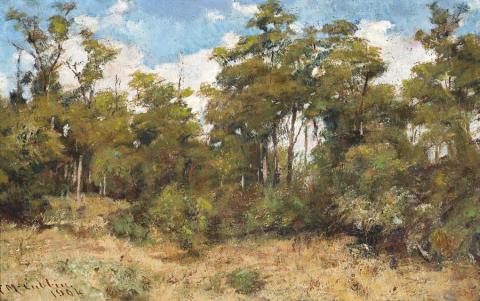GUM TREES - MT MACEDON, 1904
FREDERICK McCUBBIN
oil on canvas
30.0 x 47.0 cm
signed and dated lower left: F McCubbin. / 1904
typed label attached verso: GUM TREES - MT MACEDON
Mr Sedon-Thompson, Melbourne
Mr W. Oswald Burt, Melbourne, 1962
Private collection, Sydney, 1969
Private collection, Sydney
Possibly, Mr Fred McCubbin's Exhibition of Paintings, Athenaeum Upper Hall, Melbourne, 22 April 1904
‘You-Beaut Country': Australian Landscape Paintings 1837–1964, National Gallery of Victoria, Melbourne, 29 October – 19 December 1964, cat. 38 (as 'Bush Study, Macedon', lent by W.O. Burt, Esq.)
When Frederick McCubbin moved to Macedon in 1901 he entered upon, as his son Alexander later wrote, 'the most fertile and vigorous period of his life.'1 Some of his best and most popular works soon followed including his masterpiece, The Pioneer 1904, 'an established favorite' within a short time of its acquisition in 1906 by the National Gallery of Victoria through the Felton Bequest.2 When Childhood Fancies 1905 (private collection) was first exhibited, the art critic for The Age wrote enthusiastically, 'McCubbin has never painted a more happily inspired picture .'3 And in Lost 1907, (National Gallery of Victoria), another gem from this period, both the narrative and the early morning light filtering through the Macedon bush captured the public's imagination. McCubbin devoted himself enthusiastically to the subjects around him - 'The bush up our way looks more charming than ever', McCubbin wrote to his friend Tom Roberts in 1904. 'Pictures everywhere.'4 As the gifted interpreter of the secluded glade, he delighted in capturing the play of light in the subtlest of colours, of lyrical moments of childhood and the heroic endeavours of the early settlers of Victoria, the triptych format as much in veneration of the bush itself as of the pioneers.
Significantly, McCubbin named their family Macedon home 'Fontainebleau' after the forest in France, neighbouring the village of Barbizon and its school of plein air painters, especially McCubbin's favourite, Corot. Devoting himself to painting in the open air, he even dug a trench in the ground so that he could reach the canvas tops of The Pioneer. Now in the middle years of his art, his style became broader and vision fresher in response to painting out-of-doors directly from the motif, as readily seen in Gum Trees, Macedon 1904. The smoothly painted tight style of earlier years gave way to the freer, textured brushstroke and palette knife. These transitions are clearly visible in the comparison of Macedon landscapes such as A Bush Scene 1903, in the collection of the Art Gallery of Ballarat, and two works close to the painting on offer - The Hillside, Macedon 1904, private collection, Melbourne, and Sunny Glade.5 In these later paintings the brushstrokes are applied with such verve that they seem to dance in spontaneous response to the scene. The focus of attention had now moved from the figure to the enchanting play of light, as in Sylvan Glade, Macedon 1906, in the Bendigo Art Gallery. In radiant sunlight or in shade, each of these paintings captures the characteristic qualities of his beloved bush at Mount Macedon, one of his most fruitful paintings grounds.
1. McCubbin, A., 'Biographical Sketch of the Life of Frederick McCubbin', in MacDonald, J., The Art of Frederick McCubbin, Lothian, Melbourne, 1916, p. 65
2. 'Mr. M'Cubbin's Exhibition of Pictures', Age, Melbourne, 17 May 1907
3. 'Exhibition of Arts and Crafts', Age, 20 November 1905, p. 5
4. Letters to Tom Roberts, vol. II, Mitchell Library, State Library of New South Wales, Sydney, A2479, 7 November 1904
5. For The Hillside, Macedon see Clark, J., 'A Happy Life': Frederick McCubbin's Small Paintings & Oil Sketches, National Gallery of Victoria, Melbourne, 1991, p. 17, p. 12 (illus.), and for Sunny Glade, Sotheby's, Sydney, 25 August 2002, lot 13
DAVID THOMAS
